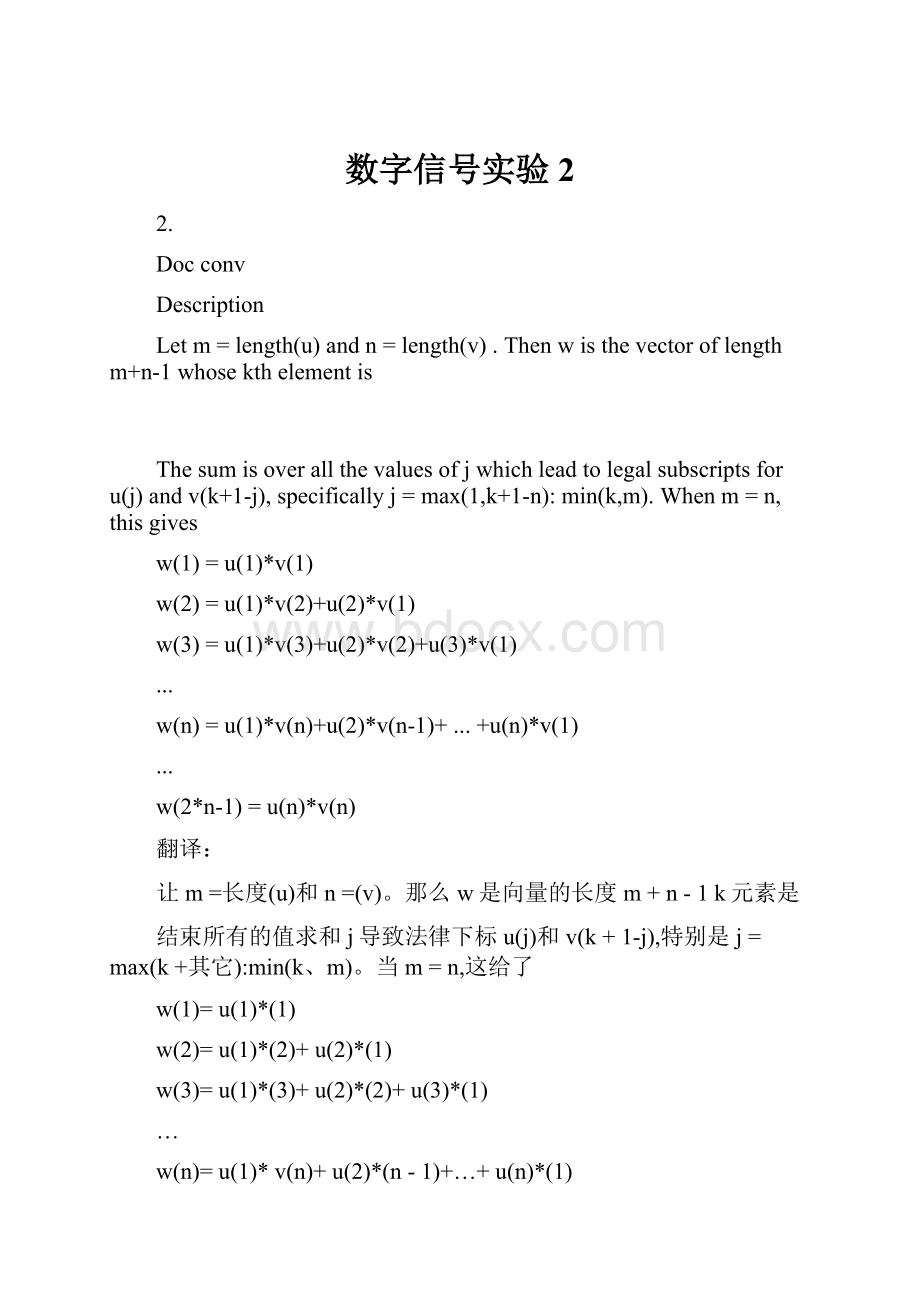数字信号实验2文档格式.docx
《数字信号实验2文档格式.docx》由会员分享,可在线阅读,更多相关《数字信号实验2文档格式.docx(43页珍藏版)》请在冰豆网上搜索。

w(2*n-1)=uv(n)*(n)
docnum2str
Thenum2strfunctionconvertsnumberstotheirstringrepresentations.Thisfunctionisusefulforlabelingandtitlingplotswithnumericvalues.
str=num2str(A)convertsarrayAintoastringrepresentationstr.Convertedfloating-pointvalueshaveamaximumoffourdigitsofprecision,andanexponentifrequired.Forintegervalues,num2strreturnstheexactstringrepresentationofthevalue.
str=num2str(A,precision)convertsthearrayAintoastringrepresentationstrwiththemaximumnumberofdigitsspecifiedbyprecision.
str=num2str(A,format)convertsarrayAusingthesuppliedformat,asdescribedonthefprintffunctionreferencepage.Bydefault,num2strdisplaysfloatingpointvaluesusingthe'
%11.4g'
format(foursignificantdigitsinexponentialorfixed-pointnotation,whicheverisshorter).
num2str函数将数字转换为字符串表示。
这个函数是用于标签和标题的情节与数值。
str=num2str(A)将一个数组转换成一个字符串str。
转换精度浮点值有最大的四个数字,和一个指数如果需要。
为整数值,num2str返回的字符串表示的值。
str=num2str(精度)的数组转换成字符串表示str由精密数字指定的最大数量。
str=num2str(格式)转换数组使用提供的格式,如流函数参考网页上的描述。
默认情况下,num2str显示浮点值使用“%11.4g”格式(四个有效数字在指数或定点表示法,哪个更短)。
Docfilter
Thefilterfunctionfiltersadatasequenceusingadigitalfilterwhichworksforbothrealandcomplexinputs.ThefilterisadirectformIItransposedimplementationofthestandarddifferenceequation(see"
Algorithm"
).
y=filter(b,a,X)filtersthedatainvectorXwiththefilterdescribedbynumeratorcoefficientvectorbanddenominatorcoefficientvectora.Ifa
(1)isnotequalto1,filternormalizesthefiltercoefficientsbya
(1).Ifa
(1)equals0,filterreturnsanerror.
IfXisamatrix,filteroperatesonthecolumnsofX.IfXisamultidimensionalarray,filteroperatesonthefirstnonsingletondimension.
[y,zf]=filter(b,a,X)returnsthefinalconditions,zf,ofthefilterdelays.IfXisaroworcolumnvector,outputzfisacolumnvectorofmax(length(a),length(b))-1.IfXisamatrix,zfisanarrayofsuchvectors,oneforeachcolumnofX,andsimilarlyformultidimensionalarrays.
[y,zf]=filter(b,a,X,zi)acceptsinitialconditions,zi,andreturnsthefinalconditions,zf,ofthefilterdelays.Inputziisavectoroflengthmax(length(a),length(b))-1,oranarraywiththeleadingdimensionofsizemax(length(a),length(b))-1andwithremainingdimensionsmatchingthoseofX.
y=filter(b,a,X,zi,dim)and[...]=filter(b,a,X,[],dim)operateacrossthedimensiondim.
过滤函数过滤数据序列使用数字滤波器工作实际和复杂的输入。
过滤器是一种直接二转置实现标准的差分方程(见“算法”)。
y=过滤器(b,a,X)过滤器过滤的数据向量X描述分子系数向量b和分母系数向量a。
如果一个
(1)不等于1,滤波器可实现滤波器系数
(1)。
如果
(1)=0,过滤器返回一个错误。
如果X是一个矩阵,过滤操作的列X如果X是一个多维数组,过滤作用于第一nonsingleton维度。
[y,zf]=过滤器(b,a,X)返回最后一个条件,过滤器的zf延迟。
如果X是一个行或列向量,输出zf是一个列向量的最大长度(长度(a)、(b))1。
如果X是一个矩阵,zf这样的向量是一个数组,一个用于每一列(X)和类似的多维数组。
[y,zf]=过滤器(b,a,X,zi)接受初始条件,子,并返回最终的条件,过滤器的zf延迟。
输入子是一个向量的最大长度(长度(a)、(b))1,或数组大小的主要维度最大长度(长度(a)、(b))1和剩余的尺寸匹配的X。
y=过滤器(b,a,X,子,暗)和[…)=过滤器(b,a,X,[],昏暗的)跨维度的操作。
Docimpz
Thenextsectionsdescribecommonimpzoperationwithadaptive,discrete-time,andmultiratefilters.Formoreinputoptions,refertoimpzinSignalProcessingToolboxdocumentation.
下一小节将描述常见impz操作与自适应离散,多重速率的过滤器。
更多的输入选项,请参阅impz信号处理工具箱中的文档。
3.docstem
num2str(pi)is3.142.
num2str(eps)is2.22e-16.
num2str(randn(2,2),3)producesthefollowingstringmatrix:
num2str(randn(2,2),3)
ans=
0.538-2.26
1.830.862
num2strwithaformatof%10.5e\nreturnsamatrixofstringsinexponentialformat,having5decimalplaces,witheachelementseparatedbyanewlinecharacter:
x=rand(2,3)*9999;
%Createa2-by-3matrix.
A=num2str(x,'
%10.5e\n'
)%Converttostringarray.
A=
6.87255e+003
1.55597e+003
8.55890e+003
3.46077e+003
1.91097e+003
4.90201e+003
data=[1:
0.2:
4]'
;
windowSize=5;
filter(ones(1,windowSize)/windowSize,1,data)
ans=0.2000
0.4400
0.7200
1.0400
1.4000
1.6000
1.8000
2.0000
2.2000
2.4000
2.6000
2.8000
3.0000
3.2000
3.4000
3.6000
Q2.1
Q2.2
Q2.3
clf;
n=0:
100;
s1=cos(2*pi*0.5*n);
s2=cos(2*pi*0.7*n);
x=s1+s2;
M=2;
num=ones(1,M);
y=filter(num,1,x)/M;
subplot(2,2,1);
plot(n,s1);
axis([0,100,-2,2]);
xlabel('
时间序号n'
);
ylabel('
振幅'
title('
信号#1'
subplot(2,2,2);
plot(n,s2);
信号#2'
subplot(2,2,3);
plot(n,x);
输入信号'
subplot(2,2,4);
plot(n,y);
输出信号'
axis;
Q2.4
Q2.5
Q2.6
Q2.7
这两个序列是相等,系统是线性
Q2.8
a=2b=2
a=3b=6
a=4b=8
Q2.9
n=0:
40;
a=2;
b=-3;
x1=cos(2*pi*0.1*n);
x2=cos(2*pi*0.4*n);
x=a*x1+b*x2;
num=[2.24032.49082.2403];
den=[1-0.40.75];
ic=[23];
y1=filter(num,den,x1,ic);
y2=filter(num,den,x2,ic);
y=filter(num,den,x,ic);
yt=a*y1+b*y2;
d=y-yt;
subplot(3,1,1)
stem(n,y);
ylabel('
加权输入:
a\cdotx_{1}[n]+b\cdotx_{2}[n]的输出'
subplot(3,1,2)
stem(n,yt);
a\cdoty_{1}[n]+b\cdoty_{2}[n]的输出'
subplot(3,1,3)
stem(n,d)
时间序号n'
差信号'
Q2.10
Q2.11
Q2.12
Q2.13
D=9
D=8
D=7
Q2.14
D=7;
a=3;
b=-2;
x=a*cos(2*pi*3*n)+b*cos(2*pi*3*n);
xd=[zeros(1,D)x];
ic=[00];
yd=filter(num,den,xd,ic);
d=y-yd(1+D:
41+D);
输出y[n]'
grid;
stem(n,yd(1:
41));
[延时输出]'
stem(n,d);
差值信号'
x=a*cos(2*pi*5*n)+b*cos(2*pi*5*n);
x=a*cos(2*pi*0.3*n)+b*cos(2*pi*0.3*n);
Q2.15
D=10;
x=a*cos(2*pi*0.1*n)+b*cos(2*pi*0.4*n);
ic=[22];
Q2.16
Q2.19
Q2.20
N=45;
num=[0.9-0.450.350.002];
den=[1.00.71-0.46-0.62];
y=impz(num,den,N);
stem(y);
冲激响应'
Q2.21
两程序所实现的功能完全一样
Q2.22
Q2.23
Q2.26
x=[1zeros(1,40)];
den=[11.62.281.3250.68];
num=[0.06-0.190.27-0.260.12];
y=filter(num,den,x);
num2=[0.2-0.50.3];
den2=[10.70.85];
num1=[0.3-0.20.4];
den1=[10.90.8];
y1=filter(num1,den1,x);
y2=filter(num2,den2,y1);
d=y-y2;
subplot(3,1,1);
四阶实现的输出'
subplot(3,1,2);
stem(n,y2);
级联实现的输出'
subplot(3,1,3);
没有差别
Q2.27
Q2.28
h=[321-210-403];
x=[1-23-4321];
y=conv(h,x);
14;
sub